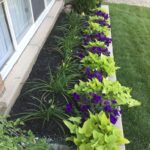Introduction
Deck gardening is a form of container gardening done on decks or balconies. It allows people to create beautiful and lush gardens without taking up too much space. This type of gardening has numerous benefits for those who choose it.
The first benefit is that it allows for limited-space gardening, allowing garden enthusiasts to enjoy the beauty of foliage and blooms in even small spaces. With deck gardening, you can grow flowers, vegetables, herbs and other plants that would otherwise be impossible in confined outdoor areas. Additionally, deck gardening is ideal for anyone who doesn’t want to invest in a large garden or invest the time or energy into maintaining one, making it an excellent choice for those with little time or who live in urban environments.
Of course, one of the best advantages of deck gardening is being able to go out onto your patio or balcony and admire the beauty of your own creations right there with you. You have greater control over your plants since they are contained within containers and require minimal weeding and maintenance – meaning all the hard work derives with ensuring they remain healthy and water if needed.
Overall, there are many benefits todeckgardening; including beautifying small spaces where necessary, providing enjoyment directly from the home without having to traverse far into nature, less maintenance than traditional gardens which requires more weeding and mowing due to its size – plus it provides an added layer of security around your property as these are raised up from mostlyoff-groundlevel by whatever elevation you decide uponfor installation (all dependent on structure supporting them). Finally deckgardeningis a great way for those living in cramped city dwellings to bring some nature—and colour—into their daily lives!
Essential Components of Deck Gardening
Deck gardening has become increasingly popular in recent years, as it allows people to grow a variety of plants and vegetables on balconies and decks without taking up too much space. For those interested in deck gardening, there are some essential components that should be considered.
First and foremost, the deck space itself should be assessed. One should determine if there is enough light present for certain types of plants to grow. If a deck does not get sufficient sunlight throughout the day, then growing a variety of plants may not be possible. In addition, one should also consider the preferred soil type necessary for certain plants. While potting soil is often recommended for specific types of plants and vegetables, it can also lead to water retention in containers which could cause root rot or other similar problems down the line.
Another important component of successful deck gardening is choosing which plants or vegetables will thrive best on the chosen deck space. Not all plants need direct light or even require regular watering, so selecting those with lower maintenance needs can help ensure a successful harvest season. Additionally, some plants do better when they are potted while others thrive with aerial roots hanging off platforms or boards created by the gardener; this will depend entirely on what type of plant is being grown. Finally, one must choose the right size container for their chosen planting materials; too big can lead to overwatering while too small can stunt growth or create an unhealthy environment for growths.
Choosing a Design for Deck Gardening
When it comes to deck gardening, the design possibilities are practically endless. Whether you’re looking to cultivate a container garden, make use of sustainable methods, or create something of an oasis in your own backyard, careful consideration should be given to the design of your ideal deck garden. We’ve compiled some tips and relevant information below to help ensure that your chosen space is well-suited for gardening and able to accommodate the range of plants and materials you’ll need.
First and foremost, be sure to measure your deck carefully before deciding on its design. This will not only help you determine how much space is available for planting and soil material but will also help you identify potential obstacles such as lighting exposure, barriers like outdoor furniture, or any architectural features present that may impact access or growth. You’ll also want to consider location when searching for the perfect spot for a vegetable garden; north-facing decks tend to be too shady while areas with high levels of sunlight could potentially require extra watering or risk withering certain plants due to higher temperatures.
Next, consider adding raised beds or planters for optimal soil drainage and nutrient retention; these are great options if you don’t have much gardener experience or are looking for solutions that require less maintenance. Additionally, try mixing different colors and textures into your garden design by selecting native species as accents amongst traditional favorites; this will break up mulch monotony while adding additional detail to create eye-catching styles. Lastly, don’t forget additional items such as birdbaths, trellises, nature sculptures – basically anything that can offer some added aesthetic value while helping emphasize existing garden elements in dramatic ways. Ultimately whatever ideas you come up with should provide a unique atmosphere tailored specifically towards those who’ll be participating in the activity most often.
Setting Up Your Deck Garden
1. Choose a spot on your deck where you will establish your garden. Make sure the area gets at least 6-8 hours per day of direct sunlight, or as much as possible, depending on your location and time of year.
2. Plan out the layout of your garden bed and make sure to leave enough space between plants for adequate air flow. Take into consideration the type of soil you’ll use and its drainage capabilities—this is especially important if you’ll be hanging plants over the sides!
3. Decide upon the types of plants you wish to grow, taking into consideration their preferred growing conditions (soil type, water needs, sunlight requirements). Research to determine which varieties thrive in your zip code and climate; selecting cold-tolerant or shade-friendly varieties such as lettuces and herbs will help extend your growing season.
4. Prepare your deck by constructing containers or raised beds if desired; choose appropriately sized containers with good drainage capabilities – either labeled “for outdoor use” or with holes drilled in each for proper aeration – filled with an appropriate mix of potting soil formulated for container gardens, compost soil from bags/in bulk, a combination thereof per plant requirements, etc.. Alternatively, build raised beds on top of existing decking (using wooden planks) leaving enough room between them for air circulation.
5. Finally, Select and Plant! As soon as you have chosen which crops to invest in along with where they should lay their roots – literally! – it is time to stock up on seeds/starts from local plant nurseries that are pesticide free and organic when possible Be sure not to overfill each container with too many plants though – they should have enough space alongside one another to flourish! You might also consider adding some supplementary items such as trellises or support cages for taller vegetables like tomatoes which will help keep them upright while yielding higher yields during harvest time!
Choosing the Right Plants for Your Deck Garden
Deck gardening is a great way to enjoy beautiful flowers and plants without taking up much ground space. Growing your own deck garden is an advantageous hobby as well since you can choose the types of plants to cultivate, control their growth and health, and enjoy their beauty all year long. When creating your deck garden, it’s important to select the right plants that will be able to survive in the conditions on the deck while also offering visual appeal.
When choosing which plants to grow in your deck garden, consider factors such as sun exposure, water requirements, soil quality and necessary nutrients. Some landscapes may vary between sunny patches or remain mostly shaded depending on where trees are located; this must be accounted for when selecting sun-loving or shade-loving varieties of plants that will best flourish in indirect light or full sun. The water source also plays a major role in determining what type of plants should be grown; many require frequent irrigation but others prefer semi-soil moisture conditions if obtaining an automatic sprinkling system isn’t possible. Additionally, applying fertilizer or potting compost annually can improve soil quality and provide essential macronutrients for your flourishing deck garden.
A wide variety of flowers and foliage can be planted for aesthetic purposes including annuals like pansies and petunias as well as evergreens like rhododendrons, boxwoods, holly trees, camellia shrubs, heirloom rosess, mums and coneflowers. Tropical varieties like bromeliads, caladiums and Ti plant can also add more vibrant colors to the outdoor living area while container-grown herbs like basil provide both beauty and fresh herbs ready for the kitchen table.
Deck Gardening Maintenance and Care
Deck gardening can be a wonderful way to spruce up any outdoor space and bring a touch of nature into your life. However, as with any gardening endeavor, proper care and maintenance is key to success. Here are some tips and best practices that can help you keep your deck garden thriving:
1. Water regularly – Make sure to water your plants on a regular schedule to ensure they receive adequate moisture. If possible, try to water early in the morning or late in the evening when temperatures are cooler and there’s less risk of evaporation. If you notice that your plants need additional water during dry spells, adjust your watering routine accordingly.
2. Fertilize – Many container plants benefit from regular fertilizing, so make sure you use the appropriate fertilizer for each type of plant in your deck garden. Refer to instructions on the product label for recommended application rates and frequency.
3. Pruning and trimming – Deadheading spent flowers or pruning overgrown branches can give tired-looking plants an instant face lift and encourage new growth during lulls between bloom cycles. When cutting back overly vigorous plants, remember it’s always better to err on the side of caution rather than taking off too much!
4. Watch for pests – Friendly bugs like ladybugs may patrol the area for pests like aphids but if all else fails, take action against detrimental bugs by lightly spraying them away with a bug spray made specifically for use on gardens or insecticidal soap spray products available at most garden centers.
5. Weed control – Pull visible weeds as soon as possible but also consider surrounding planters with decorative ground covers or mulch to discourage new weed growth overtime while bringing extra texture and color into the context of your deck garden design
Common Deck Gardening Problems and Solutions
One of the most common deck gardening problems is poor soil quality. Poor soil quality can lead to nutrient deficiencies, a lack of microbial life and an inability to support healthy plant growth. To help improve your soil, it is important to make sure that you are using properly enriched soil for the plants on your deck. Additionally, composting frequently can help improve the quality of the soil on your deck.
Another frequent issue faced by those who garden on their deck is dealing with a lack of sunlight or inadequate drainage. To increase the amount of sunlight that hits your plants, consider installing reflective surfaces such as mirrors or glass panels above them which will help to increase sun exposure. Additionally, adding a layer of gravel underneath each pot or planter will create better drainage and prevent standing water from collecting underneath your plants or containers.
Finally, one last possible problem faced when gardening on a deck is wind damage. Protecting delicate flowers and plants from wind damage can be done by staking taller flowers or putting netting around vegetable gardens to catch wind gusts before they reach vulnerable plants. Alternatively, hanging baskets can provide greater protection against wind than pots that sit on top of the railing, however if you do opt for hanging baskets make sure they are durable and secure enough to survive strong winds.
How to Upgrade and Improve Your Deck Garden Over Time
Deck gardening can be one of the easiest and most rewarding tasks for anyone looking to add a bit of nature to their outdoor space. With the right focus, maintenance and care, you can watch your deck garden blossom into something beautiful before your eyes! To make sure that your deck garden continues to reach its maximum potential over time, there are several upgrades and improvements you should consider.
Firstly, adding a trellis or arch structure can really give your space some personality, while adding height and more space for additional plants. If you have an unusually shaped deck area, use pots and containers of different sizes and shapes to bring colour and texture, while still making the most of smaller spaces. For easy maintenance, consider raised planters as these allow you access to your plants with speed and ease. Use seasonal blooms to keep things ever changing and interesting – annuals for stunning displays of big blooms in the summer months followed by pansies for winter colour. Lastly; group together plants with similar growing requirements such as sun exposure or water levels – this will ensure they settle into the space quickly without any setbacks.
Using these tips as guidance when planning out a new deck garden will help ensure it’s success over time. Make use of regular check-ups throughout all seasons to ensure that deadheading is done appropriately plus pruning where needed – this will really help certain plants thrive in uncertain weather conditions! Consider adding renewable energy sources like solar lights or wind chimes too as grown-up touches to really add some style – nothing says home like a beautifully curated garden!
Using Deck Gardening for Maximum Impact
Deck gardening is the act of creating a garden on the deck area of a house or other type of building. It is relatively simple and inexpensive to do, and it can provide a number of benefits. Deck gardening can be a great way to bring nature into your home and give yourself another space for relaxing in the outdoors. The following section will look at some ideas for deck gardening, as well as some examples of successful projects.
One popular idea for deck gardening is to build raised bed gardens. These are relatively easy to construct, and they allow for more freedom when it comes to making adjustments for drainage and soil quality. Raised beds also make it easier to access plants when you need to tend them – no more bending over! Once your raised bed is constructed, you have plenty of options when it comes to the types of plants that you can grow – from edible fruits, vegetables, and herbs to flowering shrubs and ornamental grasses.
In addition to creating raised beds, there are also other advantages when it comes to deck gardening. If you want privacy while you relax or entertain on your deck, then why not build an attractive trellis arch or wall? You can choose plants that intertwine with each other while they climb up this structure – these could include ivy vines, creeping maple bushes, or even particular types of flowering annuals or perennials. If you choose flowering foliage then these decorative elements might just attract helpful local wildlife such as butterflies and hummingbirds!
A successful example of deck gardening was created by a gardener who turned her existing wooden deck into a living outdoor space with vibrant life throughout. She started off by building retaining walls around each side so that she could define different planting sections on the level surface provided. She then planted herbs and edible flowers in one area which worked perfectly because their scent could waft around at any time while they were enjoyed fresh if needed during meals! In another section she added planters containing ornamental grasses; she chose varieties that would create beautiful rustling sounds when wind passes through them to add an extra layer of atmosphere out on her lush terrace setting!
Conclusion
Overall, deck gardening can be a great way to bring vibrant life and colour to a small outdoor space. Not only does it provide a sense of accomplishment for the gardener, but it also yields beautiful blooms or tasty vegetables, depending on what you choose to grow. Deck gardening proves that even with limited living space, anyone with an interest in gardening can still enjoy the fruits of their hobby.
Through deck gardening, one can enjoy gardening in a more intimate way by being closer to their plants. By removing the barrier of soil and containers, the greenery is right there within arm’s reach. This makes it easier than ever before to inspect plants thoroughly and nurture them properly with greater accessibility. In addition, bedding planters such as hanging baskets or elevated boxes add vertical elements while displaying different textures and styles of greenery. This gives more edge to a home’s exterior landscape design.
Deck gardening is an ideal way for gardeners of all experience levels to express their creative skills without necessarily needing large outdoor areas. Even with limited outdoor space, deck gardeners can make full use of their patio or balcony by coming up with unique designs tailored for the environment’s space and sun exposure conditions. Whether opting for shrubs and trees on one side or colourful blooms accented with herbaceous borders on another, any avid gardener would find plenty opportunity for creativity in this type of gardening arrangement

Welcome to my gardening blog! I am passionate about plants and enjoy sharing my knowledge and experiences with others. In this blog, I will write about everything related to gardening, from tips on how to get started to updates on my own garden projects.





